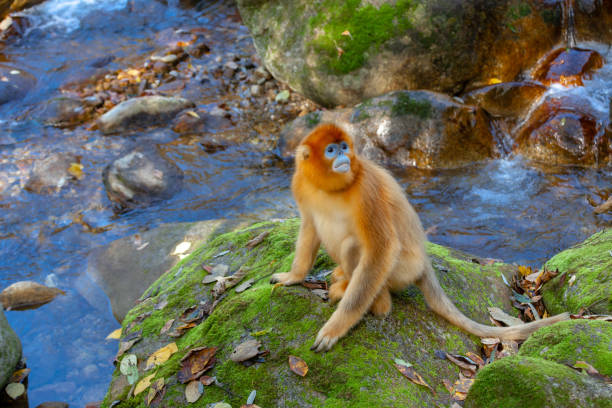Table of Contents
Scientific Classification
| Kingdom | Animalia |
| Phylum | Chordata |
| Class | Mammalia |
| Order | Primates |
| Family | Cercopithecidae |
| Genus | Rhinopithecus |
| Species | R. roxellana |
| Scientific Name | Rhinopithecus roxellana |
Description
The young Golden Snub-nosed Monkey is truly a delightful creature, almost as if it leaped right out of a storybook. With their soft golden-orange fur and adorable blue faces, these little primates radiate both innocence and energy. Typically, juveniles are smaller than their adult counterparts, measuring around 40 to 55 cm in length and weighing between 5 to 7 kilograms.
What really sets them apart is their distinctive upturned blue nose, which not only gives them their name but also adds to their unique appeal. Their wide, curious eyes reflect a blend of playfulness and innocence, perfectly capturing the essence of their early life. Interestingly, their fur is lighter than that of adults, especially during their first year, and in colder weather, it fluffs up, making them resemble tiny teddy bears.
These young monkeys are quite dependent on their troop for learning, safety, and companionship. You rarely see them alone; they’re usually close to their mothers or playfully chasing after their friends in the chilly forest.
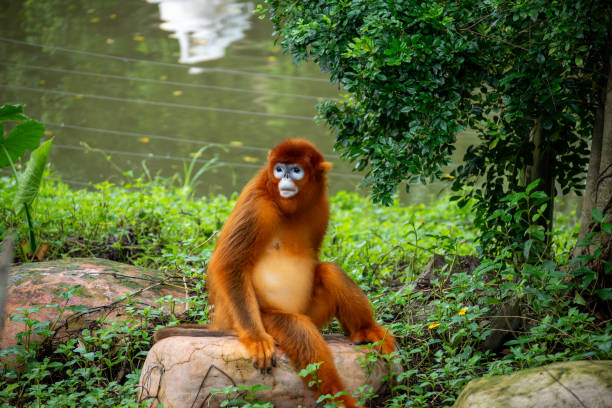
Distribution
The Golden Snub-nosed Monkey is a unique species that can only be found in China, making it a true national treasure. The young monkeys primarily inhabit three provinces: Sichuan, Gansu, and Shaanxi, with some venturing into Hubei and Henan as well.
These regions are characterized by their dense, mountainous forests, typically ranging from 1,500 to 3,400 meters in elevation. Juvenile monkeys have a fairly limited territory, so their survival hinges on the protection of their natural forest habitats.
Habitat
Juvenile Golden Snub-nosed Monkeys have quite the challenging upbringing. They call the temperate mountain forests home, where winters can be harsh and snowy. These forests are filled with a mix of coniferous and broadleaf trees, including fir, hemlock, spruce, and maple.
The young monkeys tend to hang out in the canopy, where they can leap around, play, and search for food. The adults keep a watchful eye on them, ensuring their safety. Living high up in the trees helps protect them from ground predators and also keeps their body temperature stable, as the canopy provides a shield from the biting wind.
What makes this monkey truly special is its adaptability. Unlike many primates that thrive in warm, tropical climates, it has found a way to thrive in cold, seasonal habitats. This unique trait makes it one of the few monkeys that can comfortably live a subalpine lifestyle.
Diet
Juvenile Golden Snub-nosed Monkeys have a pretty limited diet compared to their adult counterparts. Their smaller size and still-developing digestive systems play a big role in what they can munch on. But don’t let that fool you—what they do eat is packed with nutrients and changes with the seasons.
During the spring and summer months, these little monkeys enjoy:
– Young leaves
– Tender shoots
– Wild fruits
– Flower petals
As autumn rolls around, their menu shifts to include:
– Seeds
– Bark
– Lichens (which they actually rely on year-round)
Lichens might not be the most calorie-rich option, but they’re abundant and don’t have much competition from other animals. Adult monkeys often chew on these tough plants and then pass them along to the younger ones, which helps with digestion. Infants typically start sampling solid food around 3 months old and usually wean off their mother’s milk between 12 and 14 months.
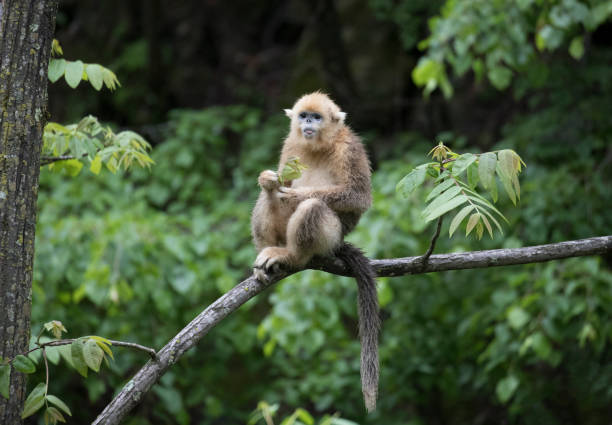
Behavior
Juvenile Golden Snub-nosed Monkeys are incredibly social and full of energy. They engage in a variety of playful activities that not only keep them entertained but also teach them essential survival skills.
Their playtime includes:
– Tag and chase
– Mock fighting
– Swinging from branches
– Climbing races
These playful behaviors help them to:
– Develop their motor skills
– Strengthen social bonds
– Grasp the hierarchy within their group
Typically, young monkeys form playgroups based on their age, while still staying close to the adult troop for safety.
When they feel scared or startled, the little ones emit a high-pitched squeal and quickly dash to their mothers or older siblings. Grooming plays a vital role in their lives, offering comfort and fostering a sense of belonging within the group.
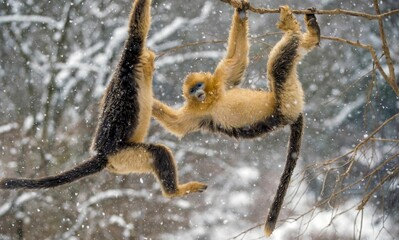
Lifespan
In the wild, Golden Snub-nosed Monkeys typically have a lifespan of around 20 to 25 years. However, young monkeys often don’t live as long due to threats from predators and environmental challenges.
Juveniles transition into sub-adults between the ages of 3 and 5, with females maturing more quickly than males. The first year of life is particularly tough for them, as mortality rates are quite high during this period. This vulnerability is largely due to harsh weather conditions, food scarcity, and attacks from predators.
On the other hand, those in captivity tend to live longer, sometimes reaching up to 28 years when given proper care.
Reproduction and Lifecycle
Golden Snub-nosed Monkeys have a pretty slow reproductive cycle, which can make it tough for the young ones to survive. This slow pace is really important for keeping their population stable.
Birth and Infant Stage:
Most births happen in the spring, between March and May.
Typically, females give birth to just one infant after a gestation period of around 200 days.
When they’re born, infants have gray fur, but they gradually start to develop that beautiful golden color over their first year.
Juvenile Stage:
This stage kicks off around 6 months of age, when the little ones start to move around more and become a bit more independent.
It lasts until they’re about 3 years old.
During this time, the young monkeys learn essential social and survival skills from their troop.
By the time they hit around 2 years old, they start hanging out more with their peers. They still come back to their mothers for grooming and comfort, but they’re becoming more self-sufficient.
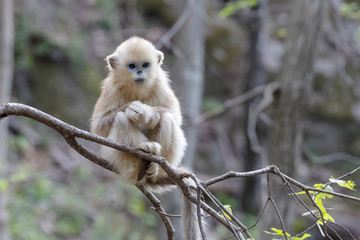
Predators
Juvenile Golden Snub-nosed Monkeys are pretty easy prey for predators. Their small size and limited agility make them quite vulnerable. On top of that, their loud and playful antics really catch the eye of potential threats.
Common Predators Include:
Martens – these agile little carnivores are often found in trees.
Raptors – particularly the larger eagles and hawks.
Leopards – while they’re not super common, they can be a serious danger in lowland areas.
To keep themselves safe from these threats, the monkeys stick together and stay alert. The adult males take on the role of sentinels while the younger ones frolic. If any danger pops up, they’re quick to sound the alarm.
Nest
Golden Snub-nosed Monkeys have a unique way of resting that sets them apart from birds and some mammals—they don’t actually build traditional nests. Instead, the young monkeys cozy up together in huddles with their families, often finding a comfy spot on high tree branches.
These huddles are more than just a place to sleep; they serve several important functions:
– Keeping warm during those chilly nights
– Offering protection from potential predators or falling branches
– Fostering social connections among family members
Moms keep their little ones close, while the kids snuggle up with their siblings or friends in these snug tree cradles, which are crafted from twisted branches.
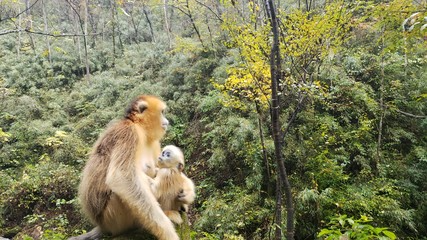
Adaptations
These monkeys thrive in a tough, chilly environment, which has sparked some remarkable evolutionary changes, particularly in the younger ones.
Key Adaptations:
– Thick, long fur that keeps them warm (one of the thickest coats among primates)
– Flat noses that help prevent frostbite
– Long tails that aid in balancing while navigating the tree canopy
– Living in large groups to stay warm and reduce the chances of being preyed upon
As they grow, juvenile monkeys experience changes in their digestive systems. They gradually learn to handle tough foods like lichen and bark, which may be hard to digest but are crucial during the lean months.
Mating Season
Golden Snub-nosed Monkeys typically mate from late August through October. While the younger ones don’t participate directly, they’re keen observers of the action. This is when they start to pick up on the intricate social dynamics that come into play among the adults.
During this period:
Males vie for the attention of females with their vocalizations and impressive displays.
Juveniles watch with curiosity, though the adults keep them at a safe distance.
Understanding these signals is crucial for the young ones as they prepare for their future roles in breeding as adults.
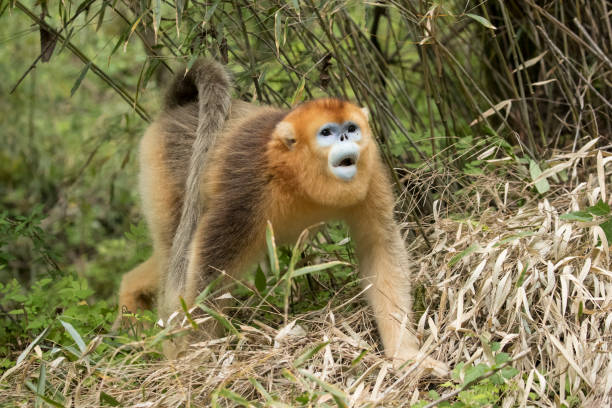
Breeding
Golden Snub-nosed Monkeys have a polygynous mating system. One dominant male mates with several females. Juveniles are usually born into harem groups. These groups have one adult male, several females, and their young.
Breeding frequency is low:
- One birth every 2 to 3 years per female
- Single offspring per pregnancy (twins are extremely rare)
Because of this, each juvenile represents a significant investment. The whole group often helps to raise and protect the young. This is called alloparenting.
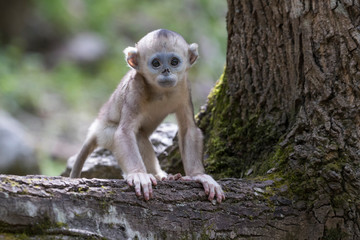
Interesting Facts
Here are some fascinating facts about these incredible creatures:
- In winter, their fur gets a cozy upgrade, growing up to 5 cm thick, while in summer, it’s a bit shorter.
- Young ones often mimic the adults, picking up on their grooming habits, vocal sounds, and even their tough postures.
- The striking blue of their faces comes from structural coloration, much like the feathers of a blue jay, rather than from any pigment.
- From a young age, juvenile monkeys can recognize the unique voices of their troop members.
- They boast an impressive 28 different vocalizations, many of which are specifically used when interacting with the younger ones.
- Juvenile monkeys often take on the role of “play therapists,” using their playful antics to lighten the mood and ease any tension within the group.
- Though they inhabit remote areas, they hold a special place in Chinese folklore, regarded as a national treasure.
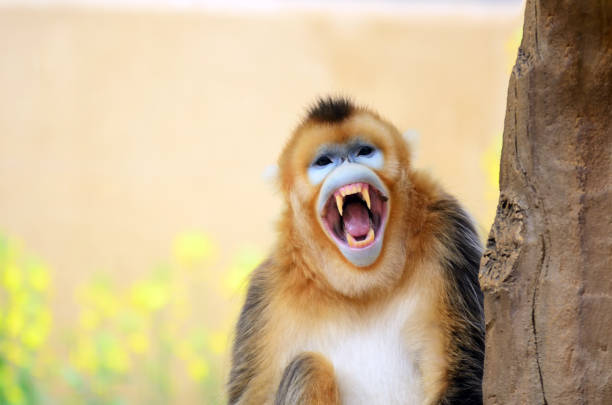
Conservation Status
The Golden Snub-nosed Monkey is currently classified as Endangered on the IUCN Red List. These young monkeys are particularly vulnerable, facing significant threats from both environmental changes and human activities.
Threats include:
– Habitat loss caused by logging and agricultural expansion
– Climate change affecting the makeup of their forest homes
– Isolated populations that result in lower genetic diversity
But there’s a silver lining:
– This species is protected by Chinese law
– Several national parks and reserves, like the Shennongjia Nature Reserve, have been established to safeguard their habitat
– Efforts for captive breeding and reintroduction are being researched and put into action
It’s vital to protect juvenile Golden Snub-nosed Monkeys, as their survival reflects the future of the entire species. This makes their conservation efforts incredibly important.
Conclusion
The young Golden Snub-nosed Monkey isn’t just a charming creature from the highlands of China; it represents resilience, innocence, and the delicate balance of mountain ecosystems. Every leap through the trees and each little chirp for its mother showcases the wonders of nature. They also serve as a poignant reminder of how crucial it is to protect these amazing animals. Their survival hinges on their natural instincts and ability to adapt, but it also relies on our commitment to safeguarding the forests they call home.


